Spain’s Hottest New Attraction Is ‘Freaky’—and Hairy
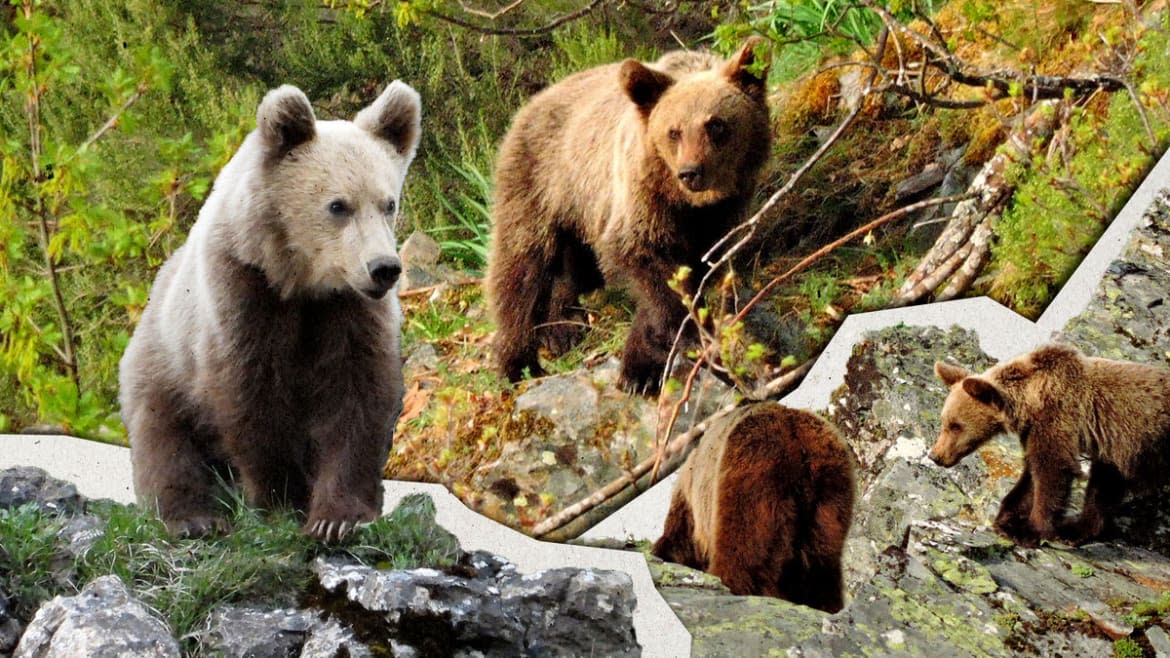
What’s the dress code for a bear hunt? In two words: nothing fancy. The packing list provided by the travel agency left no room for doubt: I was to bring “solid shoes for walking, with covered toes,” and “light layers, waterproofs and a warm coat.”
So there’d be hiking involved, and the climate might be variable, possibly damp. But then there was the color-coding. My wardrobe for the trip was to be based on “earth and foliage colors” with “bright patterns or flashy materials that cannot be found in nature” strictly prohibited. So maybe the Ibiza clubwear might be de trop.
For weeks I’d been telling anyone who’d listen about my upcoming adventure in search of bears. Some of my gay friends smirked at me, but I was way past seeing the funny side of their smutty innuendoes. Few things make me happier than the prospect of seeing rare creatures in their natural habitat, and the fact that this seemed to be possible in Spain, the relatively crowded and highly touristed country where I’ve lived for 30+ years, only added to the thrill.
On the six-hour train ride from Madrid to Asturias, I watched the dull plains of Castile billow up into folds of mountainside draped with thick vegetation and, on the highest peaks, glittering shreds of the year’s last snow. Such is Spain’s diversity, and its biodiversity, that even a short journey can bring you into an entirely different world.
Asturias is one of the four “autonomous regions” ranging along the Cantabrian coast from Galicia to the Basque Country, and an enclave that holds a special place in the hearts of true Hispanophiles. Asturias considers itself the historical nucleus of what was to eventually become Spain; it’s here that the Muslim push northwards was repelled at the battle of Covadonga in 722 A.D., paving the way for the Catholic Reconquest. A checklist of the salient points of Asturian culture might include: a unique language known as bable; a rich heritage of pre-Romanesque architecture from the sixth to ninth centuries; a ribsticking regional cuisine; cheese, of which this a veritable paradise; and cider, made and drunk here in great quantity. Oviedo, the delightfully buttoned-up little capital city, was famously praised to the skies by none other than Woody Allen. But for me the region’s outstanding feature are its landscapes, which are as wild and wooly as anywhere in Europe and as well-preserved. Asturias contains seven Biosphere Reserves and no less than a third of its territory enjoys some kind of protection.
At Oviedo railway station I joined a group organized by Steppes Travel and nature-tourism outfit Wild Spain Travel in collaboration with Fundación Oso Pardo (FOP), the Spanish NGO working since 1992 to put Spain's endangered brown bear population on the road to recovery. Also in attendance was British millionaire philanthropist Paul Lister, whose European Nature Trust (TENT) supports a range of big-deal conservation projects across the continent—including the FOP. It’s Lister’s belief that conservation groups should be making more noise in the media about the crucial work they do—hence my presence in this company.
I have a sense that for North Americans bears loom larger in the psyche than they do for us Europeans. From the U.S. and Canada come the scary, nature-red-in-tooth-and-claw tales of campers being savaged in their tents. Bears in Hollywood films are typified by that scene in The Revenant in which Leo di Caprio is comprehensively done over by a giant grizzly, doing for bears what Jaws did for sharks. The European brown bear is similar in size and morphology to its American cousin, having the same thick coat of rough hair in varying tones of brown, gray, and black, the same powerful haunches and massive paws, and the same fluffy-edged ears that dare you to call them cute. But homegrown Spanish bear lore is much less high-drama. You might see a story on the TV news: something about a bear shot by a poacher, or a sighting in a populated area. Or it might be a beekeeper, up in arms about a bear blundering into their hives and stealing all the honey. Otherwise, the question of bears impinges little on one’s consciousness.
So as we sped south into the deep countryside, I was grateful to Luis Frechilla of WST for giving me the bear facts. (Warning: this article may contain traces of bad puns on the word ‘bear.’)
Bears exist in various European countries–notably Finland, Romania, and Slovenia–and were once found all over Spain’s mountainous regions. But by 1973, when the species Ursos arctros cantabricus was finally protected under Spanish law, fewer than 60 brown bears remained, corralled in the Cantabrian mountains of the north. Genetic diversity was increasingly compromised as the remaining populations became isolated from each other. Ecologists feared the worst. “We worried that the bear wouldn't last until the millennium,” remembered Frechilla.
Half a century later the status quo has taken a radical turn.
A combination of watertight environmental protection, habitat restoration, scientific research, and outreach among local communities—most of this work undertaken by the Fundación Oso Pardo—has brought about something close to a miracle. More than 400 bears now roam the mountains of Asturias and neighboring provinces of Cantabria and Palencia, and the number continues to grow at a rate of 10-15 percent year-on-year. The FOP’s “bear corridors” formed by new plantations of fruit trees have brought disparate populations into contact, strengthening the gene pool. For once then the news is all good. Indeed, the return of Ursus arctos cantabricus is a heartening success story in a world that desperately needs more of them.
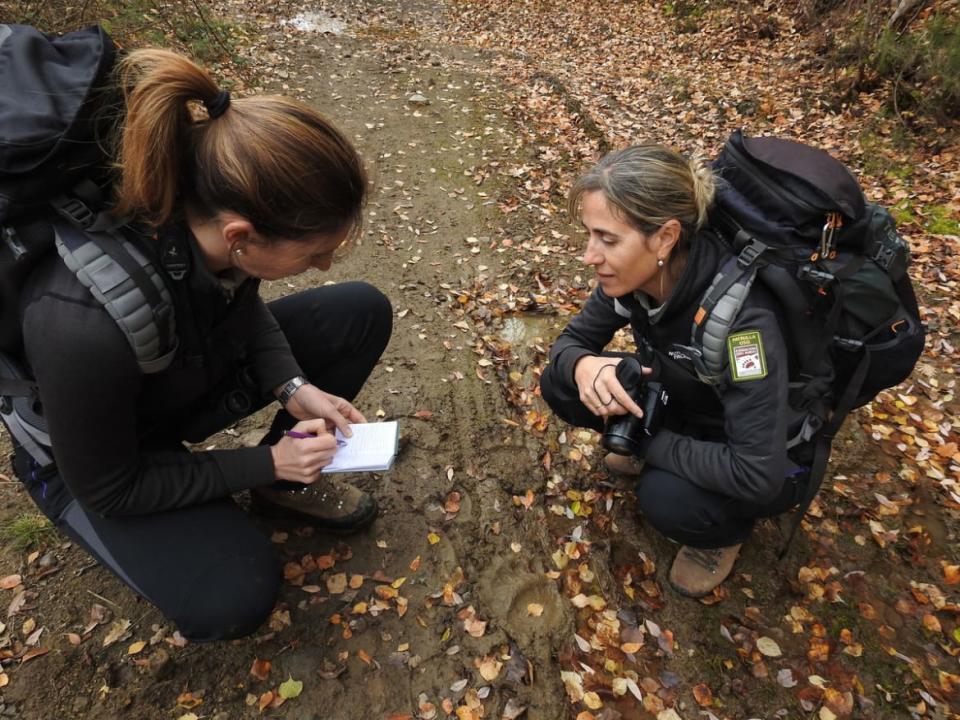
Members document a bear track.
The tour’s first stop was the Parque Natural Fuentes del Narcea Degaña e Ibias, a nature reserve in the far southwestern corner of Asturias. The Parque Natural holds within it the even more rigorously protected Reserva Integral de Muñiellos, one of Europe’s largest expanses of primary oak forest and a prime habitat for otters, wildcats, wolves—and bears. Wood from Muñiellos was used to build the Spanish Armada, but unlike most of Spain’s formerly wild areas it has remained in its pristine state. It says something about this precious place that just 20 visitors a day are allowed to enter the 14,752-acre reserve.
Victor García, another of the Wild Spain Travel guides, led the group along the only permitted route through the Reserva Integral. With his solid frame and rubicund face, it struck me García might be another example of people coming to resemble the animals they love. He was born and grew up in the hamlet of Tabrau, at the heart of the Fuentes del Narcea reserve, and saw his first bear at age 6. “I was with my father up in the hills when he handed me the binoculars. ‘Take a look at this,’ he said.” It was the beginning of a beautiful friendship—but even 10 years ago, when García began his career as a nature guide, amateur bear-spotting was very much in its infancy. “You had to be very, very freaky to be a bear-watcher,” he confided as we walked.
As spring turned to summer the Asturian countryside felt worlds apart from the dusty heats of the Spanish south. Snow-melt rivers rushed along deep valleys blanketed in fifty shades of green. The lush pastures of Muñiellos were dense with wildflowers. Along the valley path García stopped to examine a holly tree that someone, or something, had snapped at the stem. Most likely a bear looking for berries, he mused. I felt a shiver; we were getting closer to our quarry. Further down the track, the bark of a silver birch bore claw marks in five parallel lines where some zealous male had tagged his territory.
That evening we drove up into the mountains and our first lookout site, on the rim of a wooded valley opposite the craggy cliffs of La Penona. Conditions were ideal, said the guides. Spring and summer were mating time, and the bears’ blood was up. “At this time the bears are more interested in sex than food. They’re all over the place right now,” said García cheerfully.
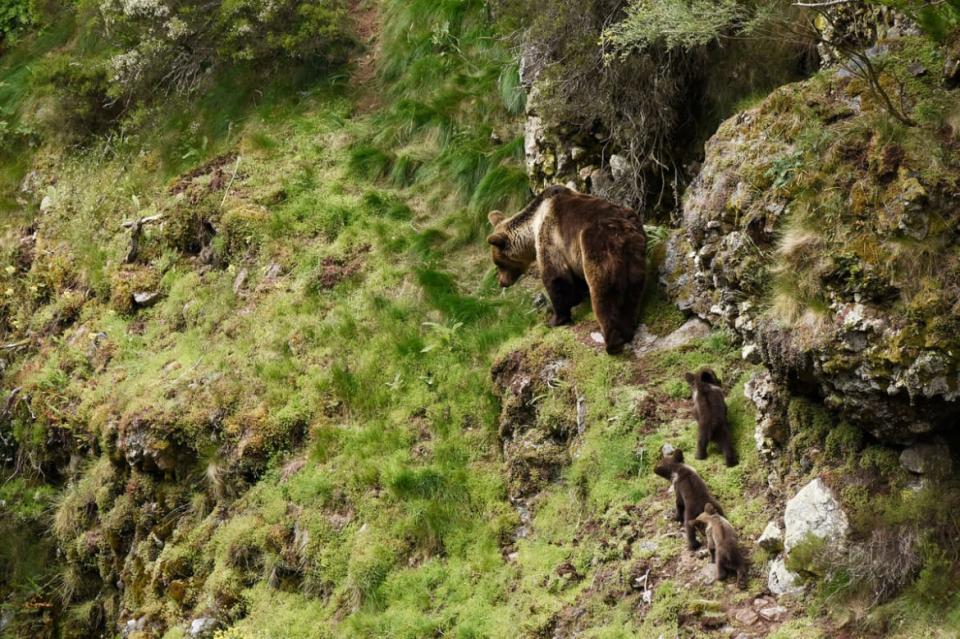
An adult Cantabrian bear with three cubs.
All over the place, except for here. The guides scanned the mountainsides with their powerful Kowa and Nikon telescopes, which have fluorite lenses and a range of half a mile or more. We waited, anticipated. But there was nothing doing–it seemed that tonight we were out of luck. The sun dipped behind a cloud, casting a sudden chill. I was glad I’d brought my Goretex jacket in those unflattering ‘earth and foliage’ colors.
It was an inauspicious start to my bear safari, and I began to have creeping doubts. Would this be like that whale-watching trip in the Canary Islands a few years back when I managed to spot a dolphin or two, but the rest was a whale of a disappointment? Going home empty-handed again, with the embarrassment of ’fessing up to my friends that I’d seen nothing–well, it didn’t bear thinking about.
Then suddenly it was lights, camera, action. “I’ve got one,” whispered Luis Frechilla in a voice charged with urgency. I hovered behind him, eager for a glimpse. When my turn came to look through the viewfinder a rush of adrenaline pumped through my veins, all my powers of attention concentrating themselves on two small patches of dark brown moving across the barren mountain perhaps a half-mile away. It was a large male pursuing a female through the rocks and scrub, both of them lumbering along with surprising speed for a creature that can weigh in at more than 500 pounds.
After the adrenaline rush came delight and relief. I watched the chase sequence up there on the hill until the dusk came down, and for the rest of the night I was high on the moment. Now everything I saw was bear-related. Checking into my room at Casa Ponce, a 250-year-old village house in the hamlet of Posada de Rengos, I noted the time-blackened wooden beams and the creaky staircase leading to my attic room below the eaves. It was as though Goldilocks had gone into business with the Three Bears and opened her own country inn.
Over breakfast Yazmin Cabrera, a Mexican who had married one of the Asturian owners of Casa Ponce, told me bear-spotting had always been a niche activity in this neck of the woods, but that she had noted an uptick in recent years. If some of her neighbors had initially been suspicious of this novelty, its value to the local economy—call it the bear market—was becoming clear even to the most recalcitrant locals. I remembered what Frechilla had told me about the across-the-board economic impact of bear tourism, estimated at 20 million euros, in these northern Spanish territories.
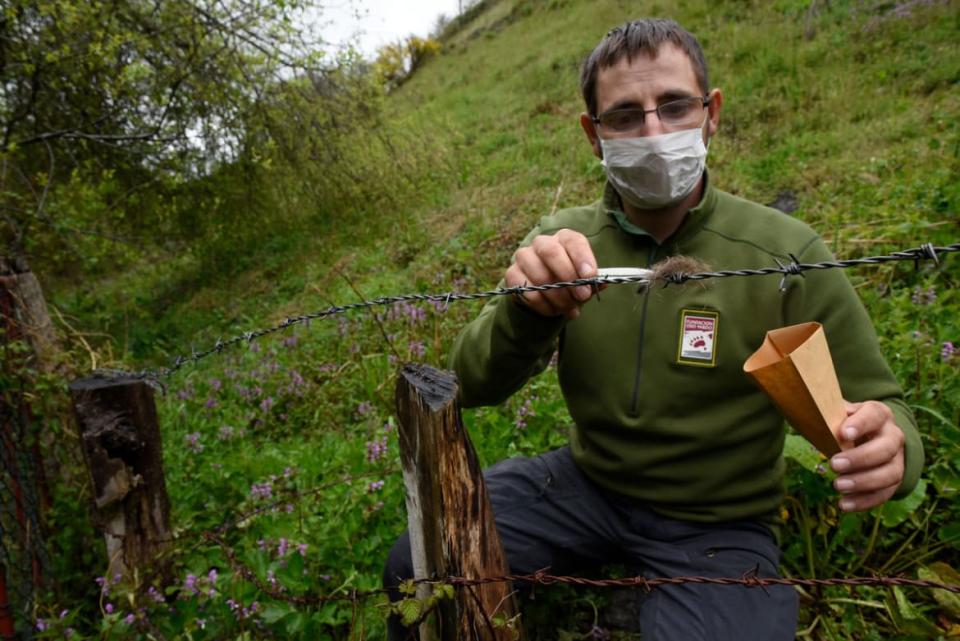
A member of the Fundacion Oso Pardo collects hair from a fence for analysis.
Fuentes del Narcea is not the area of Asturias that has benefited most from wildlife conservation, however. In the Parque Natural de Somiedo, another of the region’s spectacular nature reserves, Ursus arctros cantabricus has effectively breathed new life into a community that was withering on the vine, hollowed out by emigration and a chronically low birth-rate. At a meeting with the mayor of Pola de Somiedo, diminutive capital of the reserve, I learned that Somiedo now has 90-odd businesses interfacing with nature-based tourism, up from zero in 1988 when the park was created. The increase in the number of bears in Somiedo, from five in 1988 to 65 at present, was mirrored by the growth in the human population. The village school now had 45 pupils, said the mayor proudly; the population was steady at 1200 after years of decline. In my walks around the village I saw bear motifs—on the promotional poster for a new apartment block, on flyers for bear-watching excursions, even on my carton of locally sourced mineral water—testifying to the power of conservation to bring about social and economic change.
Now we headed to an observation site high in the remote Valle de Lago at 4245 feet above sea level. Another golden evening, another valley-side viewpoint, and another eyeful of Asturian scenery. Somiedo’s crags and peaks of quartzite and sandstone, soaring above dense beech and oak woods, reminded me how little accustomed we Europeans are to wilderness of this scale and emptiness. With an estimated ratio of 4.6 inhabitants per square kilometer, human presence in the reserve is scant indeed. In fact the valleys’ huddles of thatched stone huts seemed to me more like natural extrusions of the landscape than anything created by the hand of man.
The group was silent, tense with concentration, hunched over the telescopes. The immense wall of green opposite me was so breathtaking I could have gazed at it for hours, bears or no bears. I passed the time observing, through binoculars, a herd of wild goats placidly grazing on the highest slopes. The bear is the star of these mountains, but it shares the stage with wolves, another previously endangered and now fêted Spanish species, as well as roe deer, wildcats, and big birds of prey like the Egyptian vulture, one of which was just now swooping across the distant view.
Once again there was an urgent whisper, this time from Juan Carlos Blanco, biologist with the FOP. He had spotted a female way up on a dizzying crag far above the tree-line. She was a mature bear, coloured a dun brown with a line of graying hairs along her back. What was she doing up there on the hill? Probably steering clear of marauding males, said Blanco. It turns out female bears are nature’s own version of feminist empowerment. They live solitary lives, copulate when they feel the urge, and eventually become pregnant thanks to a process called “delayed implantation” which allows births to occur when resources are abundant.
The group was quietly abuzz with excited chatter. “Where’s she going?” “She’s moving to the left.” “She’s heading for that patch of yellow broom.” “She’s gorgeous!” She was indeed gorgeous—but there was more beauty coming right up. Some way behind the female, tumbling and rollicking, seemingly oblivious to the teetering precipice just below, were her two month-old cubs. It transpired that this was one of the 27 new bear families to have been detected in Asturias this season. What I was seeing was essentially the future of the species.
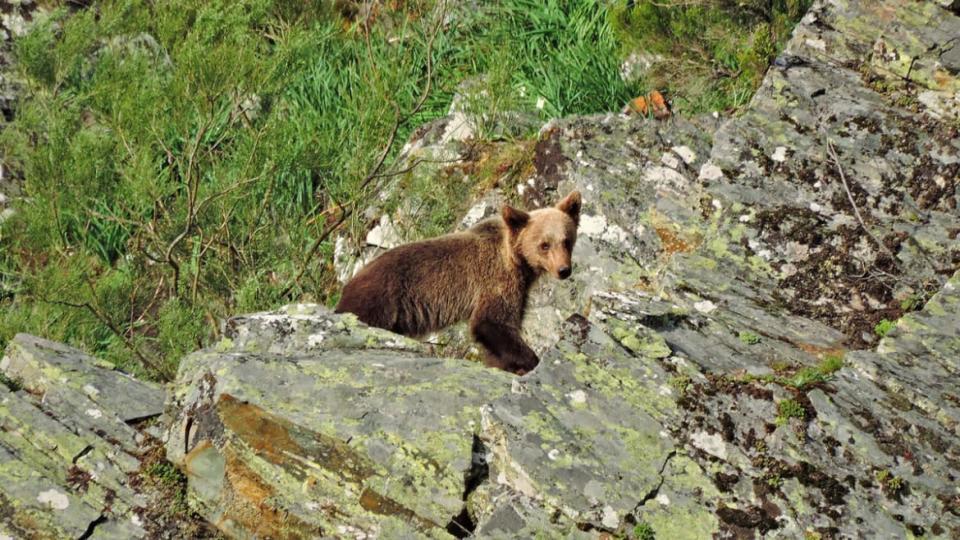
A Cantabrian bear.
If in most of the world nature is in rapid retreat at the advance of humanity, here was a rare exception. As the brown bear extends its range among the Cantabrian mountains, sightings are now possible within half an hour’s drive from Oviedo. But this in itself brings problems that will need resolving. During my Asturian journey I heard tales of bears that had ventured down into village orchards to gorge on cherries, raising hackles among the populace, or had discovered the banquet of free food to be found in trash cans. Outside the town of Proaza, a mere 17 miles from the capital, I saw easily accessible observation sites where a dozen or more bear tourists had gathered, some using social media and walkie-talkies to track down their prize. Before long some measure of regulation may be called for, said Victor García, if bears and humans are to maintain their current state of delicate equilibrium.
Now the cubs are sprawled over their mother, snoozing, lazing in the last rays of the evening sun. It’s a picture of nature’s resilience—not so much “red in tooth and claw” as nonchalantly getting on with the business of survival. Squinting through the telescope I find my vision is momentarily blurred. And it’s not just a careless touch of the big Nikon’s ultrasensitive focus wheel, but a tear that has welled up at the corner of my eye.
‘On the Trail of Bears in Northern Spain’, a seven-night trip with Steppes Travel and the European Nature Trust, costs $3266. Includes meals, Wild Spain Travel guides, and a donation to the Fundación Oso Pardo.
Get the Daily Beast's biggest scoops and scandals delivered right to your inbox. Sign up now.
Stay informed and gain unlimited access to the Daily Beast's unmatched reporting. Subscribe now.

